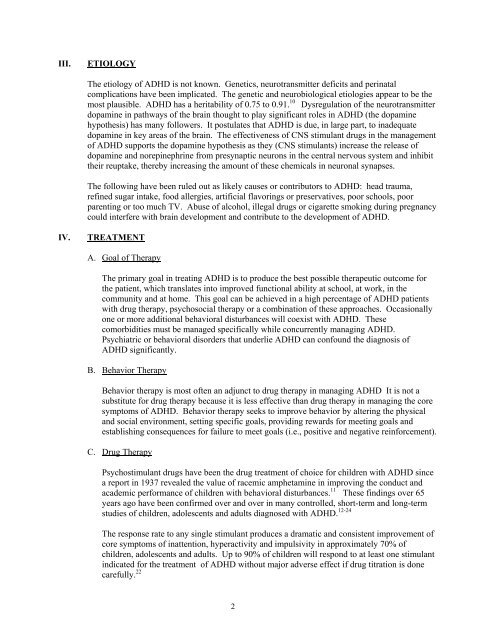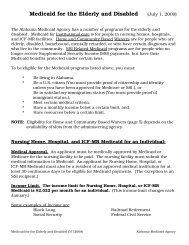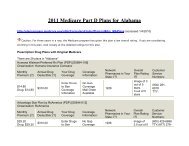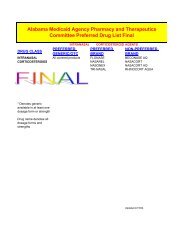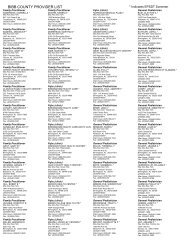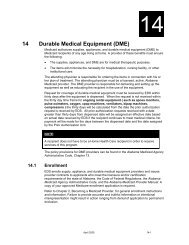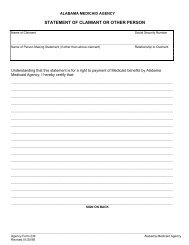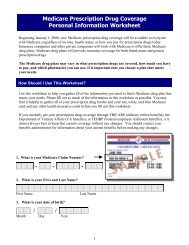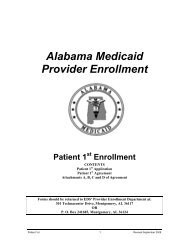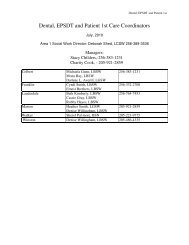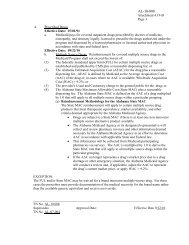PHARMACOTHERAPY REVIEW CNS STIMULANTS for treatment of ...
PHARMACOTHERAPY REVIEW CNS STIMULANTS for treatment of ...
PHARMACOTHERAPY REVIEW CNS STIMULANTS for treatment of ...
Create successful ePaper yourself
Turn your PDF publications into a flip-book with our unique Google optimized e-Paper software.
III.ETIOLOGYThe etiology <strong>of</strong> ADHD is not known. Genetics, neurotransmitter deficits and perinatalcomplications have been implicated. The genetic and neurobiological etiologies appear to be themost plausible. ADHD has a heritability <strong>of</strong> 0.75 to 0.91. 10 Dysregulation <strong>of</strong> the neurotransmitterdopamine in pathways <strong>of</strong> the brain thought to play significant roles in ADHD (the dopaminehypothesis) has many followers. It postulates that ADHD is due, in large part, to inadequatedopamine in key areas <strong>of</strong> the brain. The effectiveness <strong>of</strong> <strong>CNS</strong> stimulant drugs in the management<strong>of</strong> ADHD supports the dopamine hypothesis as they (<strong>CNS</strong> stimulants) increase the release <strong>of</strong>dopamine and norepinephrine from presynaptic neurons in the central nervous system and inhibittheir reuptake, thereby increasing the amount <strong>of</strong> these chemicals in neuronal synapses.The following have been ruled out as likely causes or contributors to ADHD: head trauma,refined sugar intake, food allergies, artificial flavorings or preservatives, poor schools, poorparenting or too much TV. Abuse <strong>of</strong> alcohol, illegal drugs or cigarette smoking during pregnancycould interfere with brain development and contribute to the development <strong>of</strong> ADHD.IV.TREATMENTA. Goal <strong>of</strong> TherapyThe primary goal in treating ADHD is to produce the best possible therapeutic outcome <strong>for</strong>the patient, which translates into improved functional ability at school, at work, in thecommunity and at home. This goal can be achieved in a high percentage <strong>of</strong> ADHD patientswith drug therapy, psychosocial therapy or a combination <strong>of</strong> these approaches. Occasionallyone or more additional behavioral disturbances will coexist with ADHD. Thesecomorbidities must be managed specifically while concurrently managing ADHD.Psychiatric or behavioral disorders that underlie ADHD can confound the diagnosis <strong>of</strong>ADHD significantly.B. Behavior TherapyBehavior therapy is most <strong>of</strong>ten an adjunct to drug therapy in managing ADHD It is not asubstitute <strong>for</strong> drug therapy because it is less effective than drug therapy in managing the coresymptoms <strong>of</strong> ADHD. Behavior therapy seeks to improve behavior by altering the physicaland social environment, setting specific goals, providing rewards <strong>for</strong> meeting goals andestablishing consequences <strong>for</strong> failure to meet goals (i.e., positive and negative rein<strong>for</strong>cement).C. Drug TherapyPsychostimulant drugs have been the drug <strong>treatment</strong> <strong>of</strong> choice <strong>for</strong> children with ADHD sincea report in 1937 revealed the value <strong>of</strong> racemic amphetamine in improving the conduct andacademic per<strong>for</strong>mance <strong>of</strong> children with behavioral disturbances. 11 These findings over 65years ago have been confirmed over and over in many controlled, short-term and long-termstudies <strong>of</strong> children, adolescents and adults diagnosed with ADHD. 12-24The response rate to any single stimulant produces a dramatic and consistent improvement <strong>of</strong>core symptoms <strong>of</strong> inattention, hyperactivity and impulsivity in approximately 70% <strong>of</strong>children, adolescents and adults. Up to 90% <strong>of</strong> children will respond to at least one stimulantindicated <strong>for</strong> the <strong>treatment</strong> <strong>of</strong> ADHD without major adverse effect if drug titration is donecarefully. 222


